Normal blood gases po2 - Study guides, Class notes & Summaries
Looking for the best study guides, study notes and summaries about Normal blood gases po2? On this page you'll find 804 study documents about Normal blood gases po2.
Page 2 out of 804 results
Sort by
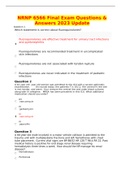
-
NRNP 6566 Final Exam Questions & Answers 2023 Update
- Exam (elaborations) • 36 pages • 2023
-
- $20.99
- 1x sold
- + learn more
NRNP 6566 Final Exam Questions & Answers 2023 Update NRNP 6566 Final Exam Questions & Answers 2023 Update Question 1 Which statement is correct about fluoroquinolones? fluoroquinolones are effective treatment for urinary tract infections and pyelonephritis Fluoroquinolones are recommended treatment in uncomplicated skin infections fluoroquinolones are not associated with tendon rupture fluoroquinolones are never indicated in the treatment of pediatric infections Question 2 A 42...

-
2022/2023 NRNP 6566 Final Exam Study Guide | Week 6-11 Fully Covered.
- Exam (elaborations) • 64 pages • 2023
-
- $11.99
- 1x sold
- + learn more
2022/2023 NRNP 6566 Final Exam Study Guide | Week 6-11 Fully Covered. Final Exam-Study Guide Week 6 and 7 1. Interpret arterial blood gases (ABG). Differentiate alkalosis/ acidosis and respiratory / metabolic 2. Identify a ventilation – perfusion mismatch and how to treat it If there is a mismatch between the alveolar ventilation and the alveolar blood flow, this will be seen in the V/Q ratio. If the V/Q ratio reduces due to inadequate ventilation, gas exchange within the affected alve...
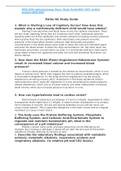
-
WGU D236 pathophysiology Exam -Study Guide-With 100% verified answers-2022-2023
- Exam (elaborations) • 26 pages • 2022
-
- $9.79
- 4x sold
- + learn more
1. What is Starling's Law of Capillary forces? How does this explain why a nutritionally deficient child would have edema? Starling’s Law describes how fluids move across the capillary membrane. There are two major opposing forces that act to balance each other, hydrostatic pressure (pushing water out of the capillaries) and osmotic pressure (including oncontic pressure, which pushes fluid into the capillaries). Both electrolytes and proteins (oncontic pressure) in the blood affect osmot...
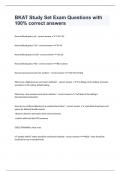
-
BKAT Study Set Exam Questions with 100% correct answers
- Exam (elaborations) • 21 pages • 2024
-
- $14.49
- + learn more
Normal blood gases; pH - correct answer 7.35-7.45 Normal blood gases: CO2 - correct answer 35-45 Normal blood gases: HcO3 - correct answer 22-26 Normal blood gases: PO2 - correct answer 80 or above Normal vacuum pressures for suction? - correct answer 120-140 mmHg What may a high pressure vent alarm indicate?
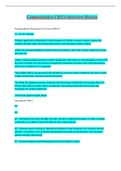
-
Comprehensive CRNA Interview Review Accurate responses are given.
- Presentation • 70 pages • 2023
-
- $18.99
- 3x sold
- + learn more
Comprehensive CRNA Interview Review Accurate responses are given. Comprehensive CRNA Interview Review Norepinephrine Mechanism of Action (MOA) A1, A2, B1 agonist. Primary agent used in distributive shock because it's ability to recruit venous volume and augment preload, while increasing arterial tone, and increasing cardiac output. Alpha one causing peripheral smooth muscle contraction. (low dose venous, high dose venous and arterial). Alpha 2 adrenoreceptor agonism actually ant...

-
2022 / 2023 NRNP 6566 Final Exam Study Guide | Week 6 – 11 Fully Covered
- Other • 67 pages • 2023
- Available in package deal
-
- $15.49
- 1x sold
- + learn more
2022 / 2023 NRNP 6566 Final Exam Study Guide Week 6 – 11 Fully Covered Week 6 and 7 1. Interpret arterial blood gases (ABG). Differentiate alkalosis/ acidosis and respiratory / metabolic 2. Identify a ventilation – perfusion mismatch and how to treat it If there is a mismatch between the alveolar ventilation and the alveolar blood flow, this will be seen in the V/Q ratio. If the V/Q ratio reduces due to inadequate ventilation, gas exchange within the affected alveo...
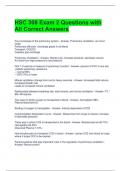
-
HSC 308 Exam 2 Questions with All Correct Answers
- Exam (elaborations) • 11 pages • 2024
- Available in package deal
-
- $13.09
- + learn more
HSC 308 Exam 2 Questions with All Correct Answers Four processes of the pulmonary system - Answer- Pulmonary ventilation- air in/out lungs Pulmonary diffusion- exchange gases in air/blood Transport- CO2/O2 Capillary gas exchange Pulmonary Ventilation - Answer- Boyles Law- Increase pressure, decrease volume Air flows from high pressure to low pressure FEV 1.0 used as a measure of pulmonary function - Answer- percent of FVC in one sec -reflects pulmonary resistance ---normal 85% ---...
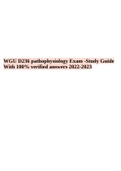
-
WGU D236 pathophysiology OA Exam -Study Guide With 100% verified answers 2022-2023.
- Exam (elaborations) • 28 pages • 2023
- Available in package deal
-
- $10.99
- 1x sold
- + learn more
WGU D236 pathophysiology OA Exam -Study Guide With 100% verified answers 2022-2023. Patho OA Study Guide 1. What is Starling's Law of Capillary forces? How does this explain why a nutritionally deficient child would have edema? Starling’s Law describes how fluids move across the capillary membrane. There are two major opposing forces that act to balance each other, hydrostatic pressure (pushing water out of the capillaries) and osmotic pressure (including oncontic pressure, which p...
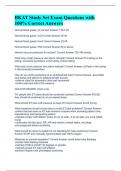
-
BKAT Study Set Exam Questions with 100% Correct Answers
- Exam (elaborations) • 13 pages • 2024
- Available in package deal
-
- $12.99
- + learn more
Normal blood gases; ph Correct Answer 7.35-7.45 Normal blood gases: CO2 Correct Answer 35-45 Normal blood gases: hco3 Correct Answer 22-26 Normal blood gases: PO2 Correct Answer 80 or above Normal vacuum pressures for suction? Correct Answer 120-140 mmhg What may a high pressure vent alarm indicate? Correct Answer Pt is biting on the tubing, excessive secretions in the tubing, kinked tubing What may a low pressure vent alarm indicate? Correct Answer cuff leak or the tubing is d...
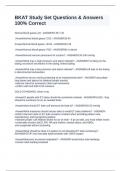
-
BKAT Study Set Questions & Answers 100% Correct
- Exam (elaborations) • 15 pages • 2024
-
- $14.49
- + learn more
Normal blood gases; pH - ANSWER7.35-7.45 AnswerNormal blood gases: CO2 - ANSWER35-45 AnswerNormal blood gases: HcO3 - ANSWER22-26 AnswerNormal blood gases: PO2 - ANSWER80 or above AnswerNormal vacuum pressures for suction? - ANSWER120-140 mmHg AnswerWhat may a high pressure vent alarm indicate? - ANSWERPt is biting on the tubing, excessive secretions in the tubing, kinked tubing AnswerWhat may a low pressure vent alarm indicate? - ANSWERcuff leak or the tubing is disconnec...

Did you know that on average a seller on Stuvia earns $82 per month selling study resources? Hmm, hint, hint. Discover all about earning on Stuvia


